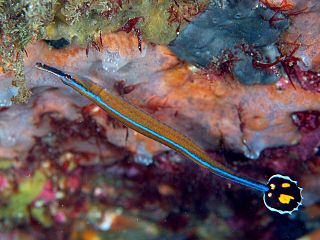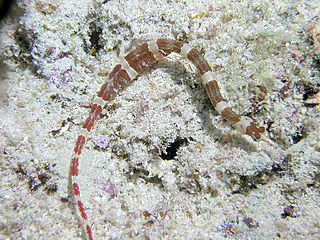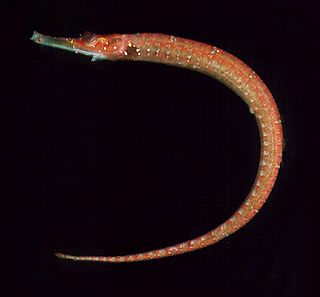
Doryrhamphus and Dunckerocampus, popularly known as flagtail pipefish, are two genera of fishes in the family Syngnathidae. They are found in warm, relatively shallow waters of the Indo-Pacific, with a single species, D. paulus, in the eastern Pacific. Most of these pipefishes are very colourful, and are fairly popular in the marine aquarium hobby despite requiring special care and not being recommended for beginners.
Doryrhamphus janssi, commonly known as the Janss' pipefish , is a species of pipefish belonging to the family Syngnathidae.

Doryrhamphus is a genus of pipefishes, one of the two genera colloquially known as flagtail pipefishes and are popular in the aquarium trade. The members of this genus are native to the Indian and Pacific Oceans where they inhabit reef environments. The species in this genus have a maximum length of 14 centimetres (5.5 in) or less, with D. janssi being the only species that surpasses 8.5 centimetres (3.3 in). Most species have a horizontal blue line along their body, and all have a whitish-edged tail that is marked contrastingly with black, red or yellow.

Corythoichthys intestinalis, known commonly as the scribbled pipefish, is a species of marine fish in the family Syngnathidae. Other common names used include banded pipefish, Australian banded pipefish, Australian messmate pipefish and messmate pipefish.

Corythoichthys amplexus, known commonly as the brown-banded pipefish, is a species of marine fish in the family Syngnathidae.

Doryrhamphus excisus is a species of flagtail pipefish from the genus Doryrhamphus. Its common names include blue-striped pipefish and blue-and-orange cleaner pipefish. The fish is found throughout much of the Indo-Pacific and tropical East Pacific.
Doryrhamphus aurolineatus is a species of flagtail pipefish from the genus Doryrhamphus that occurs in the Western Indian Ocean. It was named by J. E. Randall and John L. Earle in 1994. The fish may be found near caves, and males carry eggs in a brood pouch under the tail.

Doryrhamphus bicarinatus, or the narrowstripe pipefish, is a species of flagtail pipefish from the genus Doryrhamphus that occurs in the Western Indian Ocean, Sodwana Bay, South Africa north to Bazaruto Island, Mozambique, as well as the Maldives. It was named by C.E. Dawson in 1981. The fish's maximum length is approximately 8 cm. Males carry eggs in a brood pouch under the tail.

Doryrhamphus japonicus, or the Honshu pipefish, is a species of flagtail pipefish from the genus Doryrhamphus that occurs in the Western Pacific Ocean, from Milne Bay, Papua New Guinea, to Sulawesi, Indonesia, the Philippines, and north as far as Honshu, Japan and Korea. It is a marine demersal pipefish that inhabits coastal lagoons, rocky and coral reefs, and tidal pools down to as deep as 30 metres (98 ft) but it is unusual below 10 metres (33 ft). This species is frequently found in association with sea urchins of the genus Diadema and with sponges. It is an active cleaner, feeding on parasites found on other fishes. It frequently shares crevices with shrimps, large mud crabs and occasionally moray eels.
Choeroichthys latispinosus, also known as the Muiron Island pipefish or Muiron pipefish, is a species of pipefish native to the western coast of Australia. Described by Charles Dawson based on a single specimen in 1978, the species is still known from only three localities.

Corythoichthys flavofasciatus, known commonly as the network pipefish, reticulate pipefish and yellow-banded pipefish, is a species of marine fish in the family Syngnathidae.

Bulbanaricus davaoensis is a marine fish of the family Syngnathidae. It is found in the western Indian Ocean, the western Pacific Ocean from the Philippines to Fiji, and from Japan to the Great Barrier Reef, in Australia. Planktonic juveniles are found in the upper 200m of 610-7120m deep waters. The adult stage of this species is found among coral reefs to depths of 8m, and can grow to lengths of 4.3 cm. It is ovoviviparous, with the males carrying eggs in brood pouches until they are ready to hatch. It is a small secretive species which prefers to live among the galaxy coral Galaxea fascicularis.
Choeroichthys sculptus, the sculptured pipefish, is a species of marine fish of the family Syngnathidae.

Cosmocampus banneri is a species of marine fish of the family Syngnathidae. It is found from the Red Sea and Western Indian Ocean to Fiji, the Marshall Islands, and the Ryukyu Islands. It lives in coral reefs at depths of 2-30m, where it can grow to lengths of 5.8 cm. Although little is known about the feeding habits of C. banneri, it is expected to feed on small crustaceans similar to other pipefish. This species is ovoviviparous, with males carrying eggs in a brood pouch until giving birth to live young. The specific name honours Albert Henry Banner (1914-1985), an American carcinologist who was an expert in alpheid shrimps.
Cosmocampus darrosanus is a species of marine fish of the family Syngnathidae. It is found in the Western Indian Ocean, Sri Lanka, Indonesia, Guam, and the Great Barrier Reef (Australia). It lives in tidepools and coral reefs to depths of 3 metres (9.8 ft), where it can grow to lengths of 7.4 centimetres (2.9 in). This species is ovoviviparous, with males carrying eggs before giving birth to live young. The specific name is taken from the type locality of D'Arros Island in the Amirante Islands.

Cosmocampus maxweberi is a species of marine fish of the family Syngnathidae. It is found in the Red Sea from Sumatra to Tonga and Samoa, and from the Marshall Islands to the Great Barrier Reef. Adults live in reefs and reef-rubble to depths of 36 m, while planktonic juveniles have been found in the top 85m of 1500–2000 m water columns. Adults are expected to feed on small crustaceans, similar to other pipefish, and can grow to lengths of 10 cm. This species is ovoviviparous, with males carrying eggs until giving birth to live young. The specific name honours the German-Dutch zoologist and biogeographer Max Carl Wilhelm Weber (1852-1937).

Halicampus brocki, the tasselled pipefish, or Brock's pipefish, is a species of marine fish of the family Syngnathidae. It is found in the Indo-Pacific, from southern Japan, Guam and the Marshall Islands to the central east and west coasts of Australia. It lives on coral and rocky reefs with algae, to depths of 45 metres (148 ft). It can grow to lengths of 12 centimetres (4.7 in), and is expected to feed on small crustaceans, similar to other pipefish. This species is ovoviviparous, with males carrying eggs and giving birth to live young. The specific name honours Vernon E.Brock who was the Director of the Fish and Game Department in Honolulu.
Gray's pipefish, also known as the mud pipefish or spiny pipefish is a species of marine fish of the family Syngnathidae. It is found in the Indo-Pacific in the Gulf of Aden, Sri Lanka, and from the Gulf of Thailand to Japan, the Marshall Islands, and the Great Barrier Reef. It lives to depth of 100 metres (330 ft), and planktonic juveniles have been found above depths of 3,000 metres (1.9 mi). It occurs in muddy habitats, in estuaries, and on coral reefs, where it likely feeds on small crustaceans. It can grow to lengths of 20 centimetres (7.9 in). This species is ovoviviparous, with males carrying eggs in a brood pouch before giving birth to live young.

The Samoan pipefish, or brown pipefish, is a species of marine fish of the family Syngnathidae. It is found in the Indo-Pacific, from the Red Sea, to Sodwana Bay, to Taiwan, the Marshall Islands, and Samoa, where it inhabits tidepools and coral and rocky reefs to depths of 15 metres (49 ft). It is a solitary species with cryptic habits and is rarely observed. It is likely to feed on small crustaceans, and can grow to lengths of 14 centimetres (5.5 in). This species is ovoviviparous, with males carrying the fertilised eggs in a brood pouch, the folds of which fall well short of the centre of the egg-filled pouch, eventually giving birth to live young. The specific name honours Mataafa, a former king of Samoa. It is a listed marine species under the Australian Environment Protection and Biodiversity Conservation Act 1999.
The glittering pipefish is a species of marine coastal fish of the family Syngnathidae. It is found in the Western Pacific, from Viet Nam to Fiji and from the Ryukyu Islands to New Caledonia, where it inhabits corals, sand and reef flats to depths of 20 metres (66 ft).< It can grow to lengths of 7.3 centimetres (2.9 in), and is expected to feed on small crustaceans, similar to other pipefishes. It is secretive and rarely observed. This species is ovoviviparous, with males carrying eggs and giving birth to live young.












